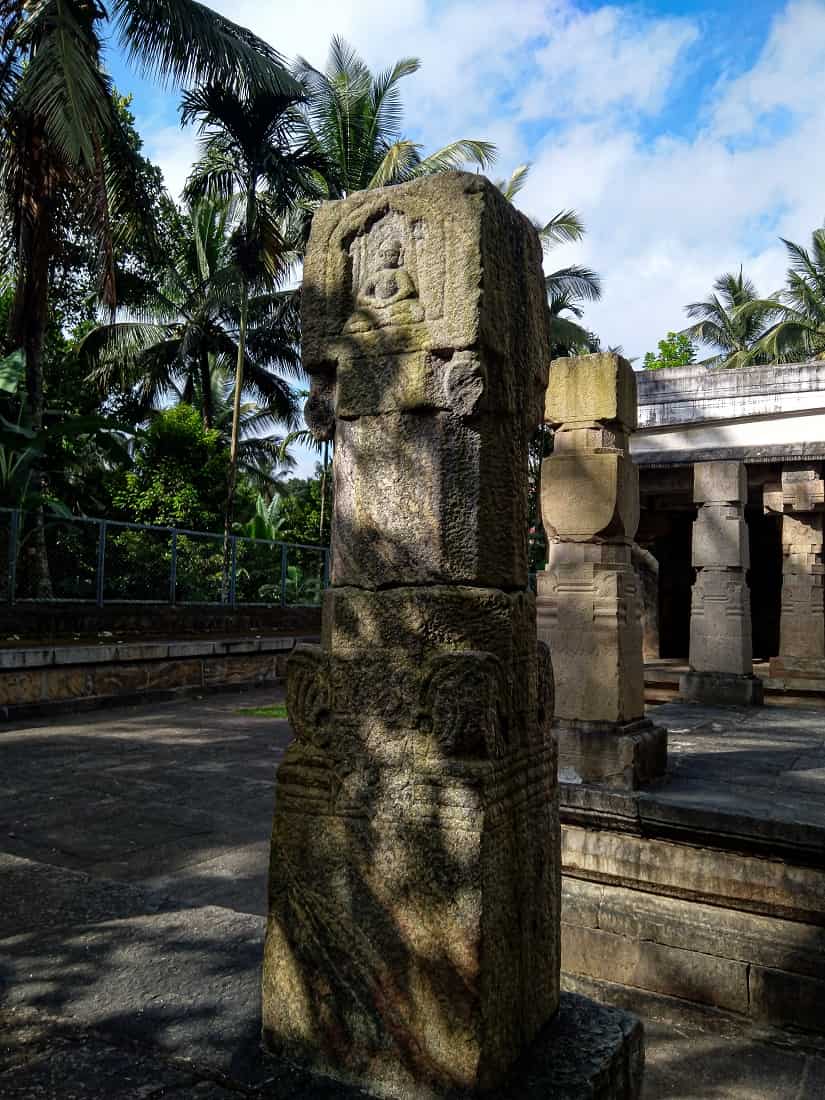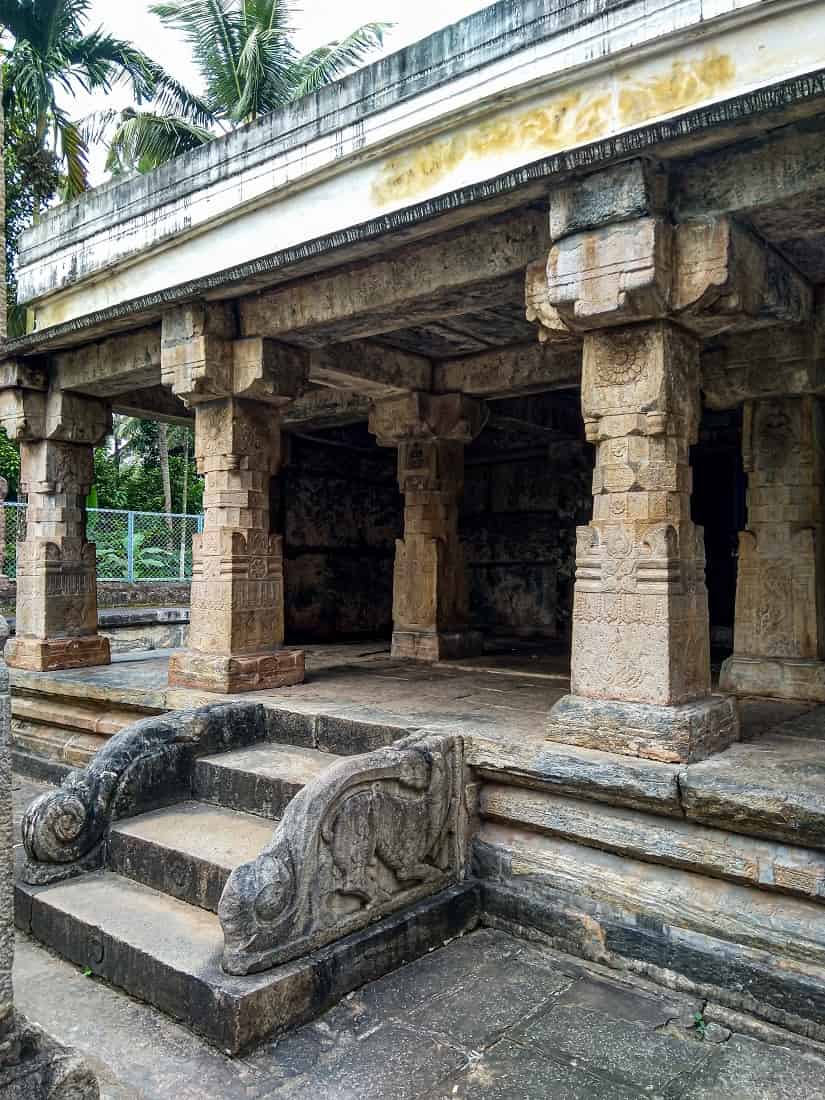Once a Mysorean military base, Sultan Bathery's Jain temple bears witness to the tribulations of Wayanad and its people
by Karthik MalliThe strikingly named Sultan Bathery, one of Wayanad’s largest towns, lies on National Highway 766 connecting Kozhikode with Mysore, both cities roughly equidistant from the town. Surrounded by the verdant forested fields characteristic of Kerala’s least populated district, Sultan Bathery is merely half an hour from Edakkal caves, home to prehistoric rock carvings and ancient inscriptions.
At the heart of the town lies a curious stone structure - a dilapidated stone temple, clearly standing out like a sore thumb in a sea of modern establishments.
The temple is rectangular, with a detached ceremonial mandapa missing its roof directly facing it, its pillars raised up to the sky. A pillared hall leads to a mandapa and from there to a garbhagriha conspicuously lacking its idol.
The walls of the temple are devoid of ornamentation, although its staircase and the pillars of the entrance porch (ardha mandapa) carry a variety of carvings - yāḷis, floral patterns, birds,and an intricate sarpabandha (snake knot).
Most tellingly however, these pillars — along with the pillars of the mandapa facing the temple — also feature carved Tīrthankara figures, making its religious affiliation to the Jain faith quite clear.

A Tīrthankara figure watches over the complex.
Of course, most visitors to the temple come here for its serenity.and architecture, rather than any religious purpose. Clusters of college boys chatter and pose for photos around the temple’s various parts, while families examine the Tīrthankara figures.
The sarpabandha carving is especially popular with visitors — according to local myth, tracing the length of the serpent from head to tail, along the exact path of its coiling engraved body, will grant one’s wishes. Every group invariably stops at the snake knot to take a closer look at it and admire its patterns.
Jainism in Wayanad
Jainism has a negligible presence in modern Wayanad — the entire district recorded a grand total of 1,797 Jains in the 2011 Census, less than .5 percent of the district’s population.
Surprisingly, even with that miniscule number, Wayanad has the highest Jain population of any district in Kerala.
What explains Jainism’s presence in such a far flung, sparsely populated region?
In fact, Jainism actually has a rich history in Wayanad, and Sultan Bathery’s Jain temple is a living testament to this..
The temple dates back to the 14th century, and is likely the oldest extant structure in the town. It was built by medieval Wayanad’s Jain community, a Kannada speaking community originally from the Mysore region, distinct from the Adivasi masses of Wayanad.
The temple’s own architecture reflects idioms current in the contemporary Kannada region — where Jainism entered medieval Wayanad from — as opposed to Kerala style architecture. Indeed, the temple is largely built in the Vijayanagara style, its pillars in particular stand out — literally in the case of the detached mandapa — as markers of this connection.
The entire temple is made of granite, with no wood used — a key feature of Kerala style temples, but also traditional churches and mosques, is the usage of wood as opposed to stone.

Entrance to the solid granite temple, with floral patterns and carvings visible.
The Jains of medieval Wayanad used the Kabini river, which flows from its source in Wayanad into the Mysore region, for sustaining trade networks. One can almost imagine them sailing up the river, boat laden with goods and money, to clustered settlements around their temples, nestled in Wayanad’s lush forests.
In fact, the area surrounding this temple was once called Hanneraḍu Bīdi, Kannada for "twelve streets", referring to the local Jain settlement. Wayanad — as bayal nāḍu in Kannada, both this and the Malayalam name translate to “land of paddy fields” — appears in several Hoysala inscriptions as well, as a contested region.
However, the Jain faith is said to have dwindled in the region in the centuries following the temple’s construction, for reasons not completely understood. Then again, it was never the faith of the majority population, local Adivasi tribes. It’s possible that these itinerant merchants began looking elsewhere for trade and the community subsequently shrank.
The Bathery Jain temple’s role in history would’ve ended here if it weren’t for later developments in the form of tumultuous political upheavals brewing in Wayanad.
Coincidentally enough, these winds of change blew from the Mysore region as well.
Wayanad and Tipu Sultan
In the second half of the 1700s, Wayanad had been annexed by Hyder Ali of Mysore to his realm. During his son Tipu Sultan’s wars in Kerala, the region served as a convenient entry point into northern Kerala through the Thamarassery ghat pass — the primary route used to enter Wayanad from Kozhikode to this very day.
At some point, the Mysore army found the Jain temple and raided it, destroying its sculptures as well. Its walled compound and its solid granite structure lent it a certain defensibility, and the Mysorean forces used it as an artillery base, a defensive position from which to fire upon enemies with cannon.
Such an encampment was historically known as a “battery”. Since this particular battery in Wayanad was associated with Tipu Sultan, it gained the name “Sultan’s Battery” in English records, Sultan Bathery in Malayalam.
The settlement that surrounded the battery came to be known by the same moniker, giving the modern town its distinctive name.
“Bathery”, the town’s Malayalam name (“Sultan” is generally omitted) is pronounced quite differently from English “battery”. This is likely an indication that the name was derived from Portuguese bateria instead, given that Portuguese was still an important language in the Indian military sphere before the British consolidated their rule over most of India.
After the defeat of Tipu Sultan at the hands of the East India Company in the Third Anglo Mysore War in 1792, Wayanad’s fate was left unclear, and it became disputed territory between both parties, with contemporary correspondence recording Mysorean raids in the region.
Of course, with Tipu’s defeat and death in the Fourth Anglo Mysore War in 1799, the East India Company could finally strengthen their hold on Wayanad.
History once again
After quelling a major revolt led by the Pazhassi Raja 1805, the East India Company consolidated their rule over Wayanad, incorporating it into the Madras Presidency.
Shortly after this, the region’s vast, forested expanses were set aside to be used for intensive plantation agriculture to meet growing consumer demands elsewhere in the world, introducing a system of cash crop cultivation and bonded labor into Wayanad.
The infusion of capitalism into Wayanad also opened it up for settlement from elsewhere in Malabar (and later Travancore), permanently changing local demographics. Soon, Malayali speaking communities — settlers and their descendants — began to outnumber local Adivasi peoples.
In his landmark Malabar Manual, written in 1887, British civil servant and Malabar Division Collector William Logan writes of “Sultan’s Battery” as “ a village of little importance”, with no mention of its Jain temple — its time had passed, once more. The Jain temple never served as a military base of any sort again.
Sultan Bathery's Jain temple has borne witness to the changing fortunes of Wayanad, from its position on Jain cultural networks, to the region's invasion by Tipu Sultan, to the large scale settlement of Malayalis in the modern era leading to Adivasis becoming a minority in their own region — in short, the trials and tribulations of Wayanad, its people, and its land.

The remnants of the detached mandapa, with Wayanad's swaying palm trees in the background.
All these narratives are inextricably tied up in one another, just like the temple’s sarpabandha that fascinates its visitors, as the cool, fresh breeze of Wayanad wafts through the air and softly rustles the stalks of its endless fields.
Karthik Malli is a freelance journalist who writes on the intersection between language, history, and culture